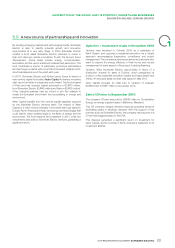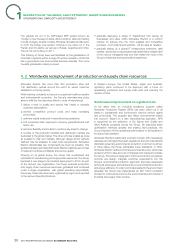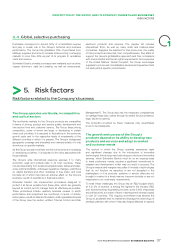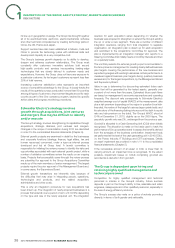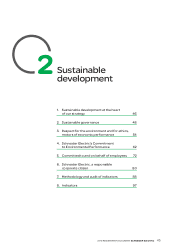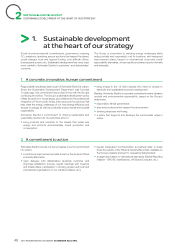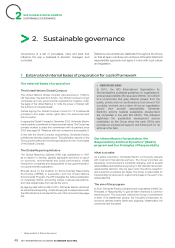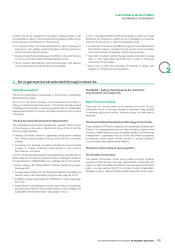APC 2010 Annual Report Download - page 44
Download and view the complete annual report
Please find page 44 of the 2010 APC annual report below. You can navigate through the pages in the report by either clicking on the pages listed below, or by using the keyword search tool below to find specific information within the annual report.
DESCRIPTION OFTHEGROUP, ANDITSSTRATEGY, MARKETS ANDBUSINESSES
1RISK FACTORS
Disputes, claims, litigation and other risks
In 2001, Schneider Electric made a public offer to purchase
Legrand as part of a proposed merger project. When the offer
closed in July2001, the Group held 98.1% of Legrand. In an initial
decision dated October 10, 2001, the European Commission
vetoed the merger, and in a second decision dated January 30,
2002, it ordered the two companies to separate as quickly as
possible. As a result, Schneider Electric sold its interest in Legrand
to the KKR-Wendel Investissement consortium even though the
Court of First Instance of the European Communities overruled the
Commission’s decisions on October22, 2002. Schneider Electric
launched proceedings against the European Commission to obtain
damages for the losses caused, estimated at EUR1.6billion. On
July11, 2007, the Court ordered the Commission to compensate
two-thirds of Schneider Electric’s losses, once their amount has
been determined. The Commission appealed this decision. On
July16, 2009, the Court of Justice confi rmed the Commission’s
non-contractual responsibility in the matter, acknowledging that
the Commission had been at fault and that losses had been
caused. However, the Court of Justice overturned the Court of First
Instance’s ruling concerning damages, fi nding that the Commission
was not liable for the loss in value incurred by Schneider Electric on
its Legrand shares. According to the ruling, the only compensation
due Schneider Electric concerns the legal fees from the second
merger investigation in October 2002. The defi nitive amount of
these fees was established at EUR50,000 by a decision of the
Court of Justice on June9, 2010, and this sum was paid by the
Commission to Schneider Electric in December2010. This dispute
is therefore closed.
Following public offers launched in 1993 by SPEP (the Group
holding company at the time) for its Belgian subsidiaries Cofi bel and
Cofi mines, Belgium initiated proceedings against former Schneider
Electric executives in connection with the former Empain-Schneider
Group’s management of its Belgian subsidiaries, notably the
Tramico sub-group. At the end of March2006, the Brussels criminal
court ruled that some of the defendants were responsible for certain
of the alleged offenses and that certain of the plaintiffs’ claims were
admissible. The plaintiffs claim losses of EUR5.3million stemming
from management that reduced the value of or undervalued
assets presented in the offering prospectus, as well as losses of
EUR4.9million concerning transactions carried out by PB Finance,
a company in which Cofi bel and Cofi mines had a minority interest.
In its ruling, the court also appointed an expert to assess the loss
suffered by those plaintiffs whose claims were ruled admissible. The
expert’s report was submitted in 2008. The defendants contest the
amounts provided by the expert in their entirety, based notably on
reports produced by Deloitte. Schneider Electric and its Belgian
subsidiaries Cofi bel and Cofi mines were held civilly liable for the
actions of their senior executives who were found liable. Schneider
Electric is paying the legal expenses not covered by insurance of
the former executives involved. The case is pending before both the
Brussels Court of First Instance and the Brussels Appeals Court, as
parts of the March2006 ruling have been appealed.
In addition, the new owners of the Tramico sub-group, to which
a Cofi mines subsidiary had advanced funds during the sub-
group’s liquidation, refuse to pay back said funds and are claiming
compensation for having been involved in the Belgian legal
proceedings. Arbitration proceedings are currently under way in
Geneva.
In connection with the divestment of Spie Batignolles, Schneider
Electric booked provisions to cover the risks associated with certain
major contracts and projects. Most of the risks were extinguished
during 1997. Provisions were booked for the remaining risks, based
on management’s best estimate of the expected fi nancial impact.
Schneider Electric, in addition to other sector companies, has
been involved in legal proceedings initiated by the European
Commission with regard to an alleged agreement concerning gas
insulated switchgears (GIS), and this was because of two former
subsidiaries operating in the high voltage segment that were sold in
2001. Schneider Electric did not appeal the decision made by the
Commission with regard to this matter on January24, 2007.
Proceedings were launched in 2007 by the competition authorities
in New Zealand for the same reasons and against the same
companies. As regards Schneider Electric, these proceedings
concerned a transaction carried out in early 2009. The company is
required to cooperate in the local investigation with New Zealand’s
competition authorities if requested.
In the same context, EDF Energy UK launched a claim for damages
of GBP15million at the High Court in London on May21, 2010.
This claim is currently being investigated.
Schneider Electric was also among 2,000 companies based all
over the world that were mentioned in the Volcker Oil for Food
report published by the UN in October2005. It was investigated
by the French judicial system in 2010 with regard to this report,
which stated that the Group had entered into agreements with
Iraqi government bodies between 2000 and 2004, under which
surcharge payments are alleged to have been made to the Iraqi
government of around USD450,000, violating the provisions of the
embargo in force at that time.
Various other claims, administrative notices and legal proceedings
have been fi led against the Group concerning such issues as
contractual demands, counterfeiting, bodily harm and work
contracts.
Although it is impossible to forecast the results and/or costs of
these proceedings with certainty, Schneider Electric considers that
they will not, by their nature, have signifi cant effects on the Group’s
business, assets, fi nancial position or profi tability. Moreover,
Schneider Electric knows of no other disputes that could have a
signifi cant impact on its business.
2010 REGISTRATION DOCUMENT SCHNEIDER ELECTRIC42



